 |
||||||||||||||||||||||||
THE LAST JOURNEY |
||||||||||||||||||||||||
|
Reflections on the Ratinlinxul Vase and others of the same theme
by Justin Kerr (Revised October, 2001) |
||||||||||||||||||||||||
| A vase in the collection, of the University Museum, The Ratinlinxul Vase has been described in various ways. In the fourth edition of The Ancient Maya, the portrayal is as follows: A third vase from Ratinlinxul in the same region shows a noble, identified as a merchant, borne in what appears to be a basketry palanquin suspended from carrying poles on the shoulders of retainers. A dog stretches himself realistically below the palanquin. Five retainers follow: the first carries a jaguar cushioned throne, the next three carry what appear to be canoe paddles; and the last grasps a fold of cloth in his left hand.. (K594) |
||||||||||||||||||||||||
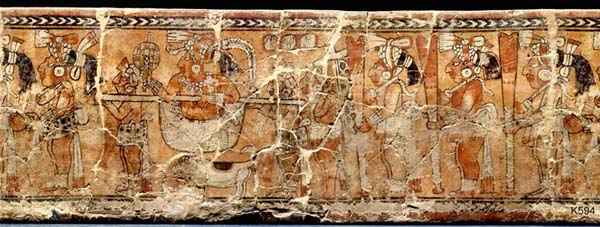 |
||||||||||||||||||||||||
| It has long been my contention that this journey is not that of a merchant and his retainers and paddlers, but rather a depiction of the last earthly trek taken by the individual in the palanquin, accompanied by his retainers and musicians. It is an expedition to the other world; in other words, this is a funerary procession. I believe that the Maya artists had no problem indicating deceased individuals as still alive, in these scenes on vessels. Another vase of the same scene has been recorded for The Maya Vase Book corpus (Volume 6) .(K5534) Although the scene recorded is the same as K594, the artist is not of the same caliber as that of the painter of the Ratinlinxul Vase. However, he has indicated clues that clarify the meaning of the journey that is being recorded. |
||||||||||||||||||||||||
 |
||||||||||||||||||||||||
| The crux of the argument is apparent as we look at the head of the noble in the palanquin. On vase Kerr no. 5534, there is a flare emanating from the forehead of the noble. This symbol of God K is known from a number of different sources. It is used by rulers to indicated their divinity at the moment of their death and passage into the other world. The most famous example is that of Pacal's sarcophagus portrait (Fig. 3), where he wears the God K flare as he enters the maw of the Xibalban monster. Another example is that on Copan stele 11 (Fig. 4), where Yax Pac wears the God K flare, and on a bone carving from Copan (Fig.5), showing Yax Pac being prepared for resurrection (dressed in his costume and jewels,) as was Hun Hunahpu, the Maize God. | ||||||||||||||||||||||||
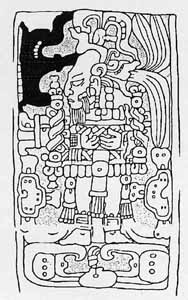 |
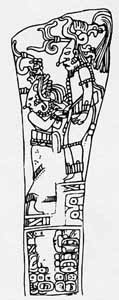 |
|||||||||||||||||||||||
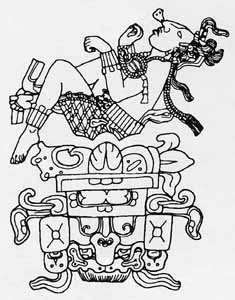 |
||||||||||||||||||||||||
|
Figure 3 Figure 4 Figure 5
|
||||||||||||||||||||||||
| On both vases bearers carry jaguar skin covered throne backs. I have recently pointed out that there is a possibility that the form of the way glyph itself may stem from these jaguar skin covered throne backs or seats. There are a number of vases showing the ways in procession with their alter egos moving to the other world. I believe that the same concept is at work here. The way in the form of the throne sacred bundle, is accompanying the noble to the other side. In a procession like this we can expect to see trumpets rather than canoe paddles. On vase Kerr no. 5534, (above) the depiction of the trumpet is more evident and the trumpeter carries a rattle or fan as well. On vase Kerr no. 5394 (Fig. 6), the trumpeters (there are three indivduals on this vase) are carrying the same style of instrument and carrying rattles or fans. On vase Kerr no. 1728, (Fig. 7), another vase with a litter, the litter bearerbalso carries a long staff with a mouthpiece similar to the trumpets on the Ratinlinxul vase. Barbara MacLeod has pointed out that the glyph on the vase in conjunction with this object means trumpet. |
||||||||||||||||||||||||
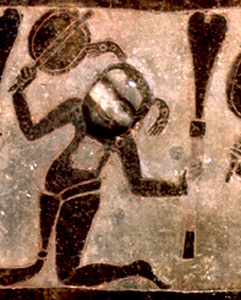 |
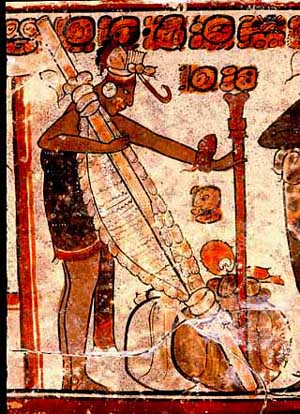 |
It has long been suggested that the dog in the Maya realm is a guide to Xibalba and that is probably his function in these scenes. I would also suggest that many of the dogs so lovingly crafted in the western part of Mexico fulfill the same function. The so called "reclinario" of the shaft tombs, erroneously referred to as parrots are in reality dogs and the dead recline their heads on the guide that will escort them to the other world. |
||||||||||||||||||||||
| Figure 6 | Figure 7 | |||||||||||||||||||||||
 |
 |
|||||||||||||||||||||||